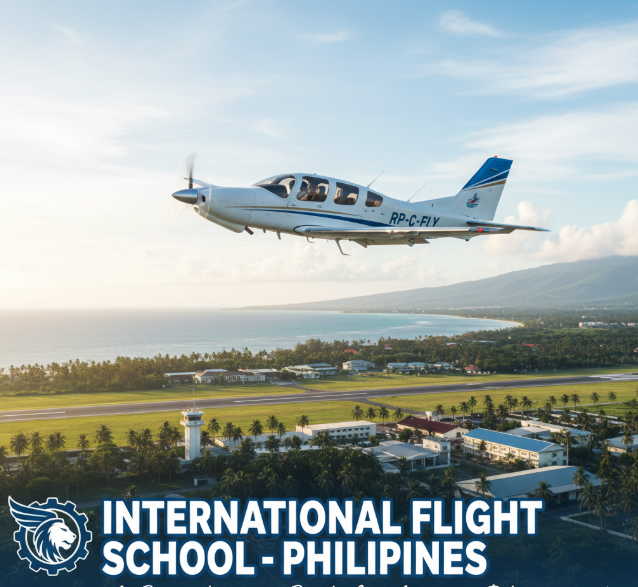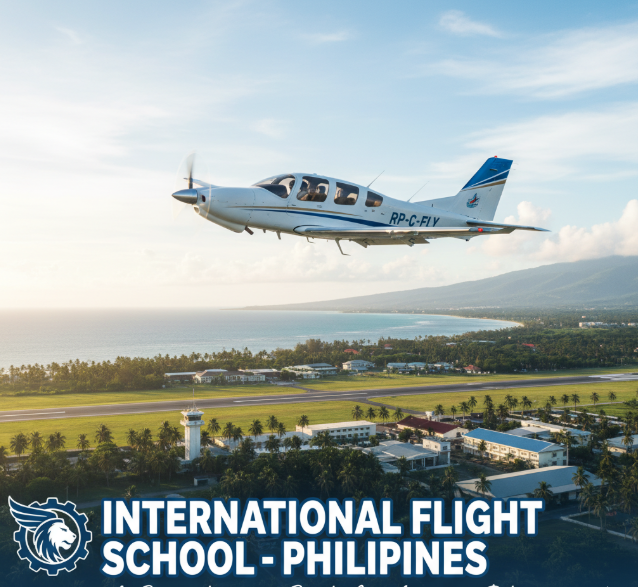
The aviation industry in the Philippines has been steadily growing, and as a result, the demand for skilled pilots is higher than ever. For those aspiring to soar the skies and build a rewarding career in aviation, attending an international flight school in the Philippines can be a life-changing decision. This comprehensive guide will explore everything you need to know about international flight schools in the Philippines, including eligibility, training programs, the future of aviation in the country, and much more.
Introduction to International Flight School in Philippines
An international flight school in the Philippines offers comprehensive training for aspiring pilots from around the globe. These institutions provide high-quality education and practical training to develop the skills required to fly various types of aircraft. Whether you’re aiming to become a commercial airline pilot, a private pilot, or even a flight instructor, enrolling in a reputable flight school is the first step to achieving your aviation goals.
What is an International Flight School?
An international flight school provides pilot training that meets global aviation standards. These schools not only cater to local students but also attract aspiring pilots from abroad, offering a range of programs that prepare them for international flying roles. These programs typically include theoretical lessons, practical flight training, simulator training, and specialized courses for different types of flying licenses.
Importance of Aviation in Philippines
Aviation plays a significant role in the Philippines, which is an archipelago of more than 7,000 islands. The country’s geographical landscape makes air travel essential for both domestic and international connectivity. The aviation industry is crucial for facilitating tourism, trade, and communication across the islands and with the rest of the world.
Moreover, the Philippines has become a hub for low-cost carriers and has seen a rise in international air traffic. This creates a continuous demand for pilots, making flight training programs in the country a prime opportunity for individuals interested in pursuing a career in aviation.
Economic and Employment Opportunities
The aviation sector is a significant contributor to the Philippine economy. According to reports, the aviation industry provides thousands of jobs and contributes billions to the country’s GDP annually. Additionally, with international carriers flying in and out of major airports like Ninoy Aquino International Airport (NAIA), there are abundant employment opportunities for well-trained pilots.
History and Development of Aviation in Philippines
Early Aviation History of the Country
The Philippines’ aviation history dates back to the early 1900s when the first flight took place in 1911. The Philippines was one of the first countries in Asia to have an air force, and since then, the aviation industry has flourished. The country has developed its aviation infrastructure, from military airports to commercial aviation hubs. Over the years, various local and international airlines have contributed to the country’s growing aviation landscape.
Milestones in Philippine Aviation
The aviation sector in the Philippines has seen numerous milestones. Key developments include the establishment of local airlines, such as Philippine Airlines (PAL) in 1941, the opening of major airports across the country, and the country’s participation in international aviation agreements. The Philippine government’s support for aviation has also played a key role in boosting its growth.
Furthermore, in recent years, the Philippines has become a popular destination for international travelers, further strengthening the importance of the aviation industry in the country.
Current Role of International Flight School in Philippines
How These Institutions/Programs Function Today
International flight schools in the Philippines are now recognized for providing world-class pilot training. These schools offer a range of programs, from private pilot licenses to commercial airline pilot programs. They function by combining ground school (theory lessons) with practical flight training to ensure students gain the necessary knowledge and skills.
Modern flight schools also incorporate cutting-edge technology, such as flight simulators and digital cockpits, to provide realistic training experiences. This helps students prepare for various flying conditions, aircraft types, and real-world aviation scenarios.
The Role of These Schools in Civil Aviation
International flight schools in the Philippines play a crucial role in the country’s civil aviation sector. They supply the aviation industry with skilled pilots who are equipped with the necessary knowledge and practical skills to safely operate commercial aircraft. Moreover, these schools help meet the increasing demand for qualified aviation professionals, particularly in the airline and private aviation sectors.
Eligibility, Training, and Skills Required
Basic Qualifications
Before enrolling in an international flight school in the Philippines, there are several qualifications you must meet:
- Age: Most flight schools require candidates to be at least 17 or 18 years old to begin their training.
- Education: A high school diploma is generally required, though some schools may prefer students who have completed higher education.
- Health: Good physical health is essential. Aspiring pilots must pass medical examinations to ensure they meet the health standards required for flying.
- Language Proficiency: Since English is the international language of aviation, proficiency in English is essential.
Technical & Soft Skills
To succeed in flight training and in a career as a pilot, students need to develop both technical and soft skills.
- Technical Skills: These include knowledge of navigation, meteorology, aviation regulations, flight planning, and aircraft systems.
- Soft Skills: Leadership, communication, problem-solving, and decision-making are essential for pilots to manage in-flight operations and emergency situations effectively.
Institutes, Academies, and Training Centers in Philippines
Here are some of the prominent flight schools and aviation academies in the Philippines:
- Philippine Airlines Aviation School (PALAS)
One of the leading aviation schools in the country, PALAS offers pilot training programs in collaboration with the national carrier, Philippine Airlines. - Cebu Pacific Air Pilot Academy
Known for its comprehensive pilot programs, this academy trains students to become commercial airline pilots, focusing on safety, efficiency, and professionalism. - Airlink International Aviation School
Offering programs such as pilot training, aircraft maintenance, and aviation management, Airlink is a prominent aviation institution in the country. - University of the Philippines Diliman – College of Engineering (Aerospace Engineering)
UP Diliman offers an undergraduate program in Aerospace Engineering, which prepares students for a career in aviation and aerospace fields. - Fil-Asian Aviation School
Located in Batangas, Fil-Asian offers pilot training programs with modern flight simulators and experienced instructors. - Aviation Institute of the Philippines
Located in Parañaque, this institute offers various aviation programs, including commercial pilot training and aircraft maintenance courses.
Government Initiatives
The Philippine government has also played an important role in supporting aviation education and training. The Civil Aviation Authority of the Philippines (CAAP) regulates the aviation industry, ensuring that training institutions maintain high standards. Furthermore, international collaborations with agencies such as NASA, ISRO, and the European Space Agency are shaping the future of aviation in the country.
Technology and Innovation in Aviation Training
Flight Simulators and Digital Cockpits
Flight schools in the Philippines are incorporating advanced technology into their training programs. Modern flight simulators and digital cockpits allow students to practice flight maneuvers in a controlled environment. This helps students gain experience without the risks associated with real-world flying.
AI in Space Travel and Cockpit Training
In line with global trends, some flight schools in the Philippines are also exploring the use of Artificial Intelligence (AI) to enhance flight training. AI-driven flight simulators and cockpit systems are being integrated to train pilots for space travel and advanced aviation systems, preparing them for the future of aviation.
Challenges Faced in Pilot Training in Philippines
Infrastructure Gaps
While the Philippines is home to several reputable flight schools, there is a need for more modern infrastructure, such as more advanced simulators and aircraft fleets, to meet the growing demand for pilot training.
Costs and Regulatory Hurdles
The cost of flight training is another challenge. It can be expensive to obtain a commercial pilot license in the Philippines, and students often need financial support to pursue their training.
Brain Drain
Many skilled pilots trained in the Philippines leave to pursue opportunities abroad, which can create a gap in the domestic aviation workforce.
Future of International Flight School in Philippines
The future of international flight schools in the Philippines looks promising. With the rise of space tourism, private aviation, and AI-powered cockpit training, the demand for skilled pilots is expected to grow even further. National projects, such as the Gaganyaan mission by India and the Artemis program by NASA, may also offer new opportunities for Filipino pilots to participate in global aviation and space exploration efforts.
Career Path & Opportunities
Step-by-Step Career Path
- Education: Obtain a high school diploma, followed by enrolling in an aviation school.
- Pilot License: Complete the required training programs to obtain a private pilot license (PPL), followed by commercial pilot training to earn a commercial pilot license (CPL).
- Advanced Training: Pursue specialized training programs, such as type ratings for specific aircraft.
- Join Airlines or Space Programs: Work for local or international airlines, or explore opportunities in private aviation or space programs.
Salary Expectations and Global Scope
While salary expectations vary based on experience and role, pilots in the Philippines can expect competitive salaries, particularly if they work for international airlines. Filipino pilots also have the opportunity to work abroad in countries with high demand for skilled aviation professionals.
FAQs
1. How much does pilot training cost in the Philippines?
The cost of pilot training in the Philippines can range from PHP 1.5 million to PHP 3 million, depending on the type of training and the flight school.
2. Which is the best aviation institute in the Philippines?
There are several great options, including Philippine Airlines Aviation School, Cebu Pacific Air Pilot Academy, and Airlink International Aviation School.
3. What qualifications are needed for pilot training in the Philippines?
A high school diploma, physical fitness, and proficiency in English are basic requirements to start pilot training.
4. Is international flight training available in the Philippines?
Yes, several flight schools in the Philippines offer training that meets international aviation standards.
5. What is the future of aviation in the Philippines?
The future is bright with growing demand for pilots, the rise of space tourism, and advancements in AI-driven aviation training.
Conclusion / Final Thoughts
Becoming a pilot in the Philippines is an exciting and rewarding career path. With the country’s expanding aviation industry and the presence of reputable international flight schools, aspiring pilots have ample opportunities to build a successful career. If you’re passionate about aviation, now is the perfect time to explore pilot training in the Philippines.
